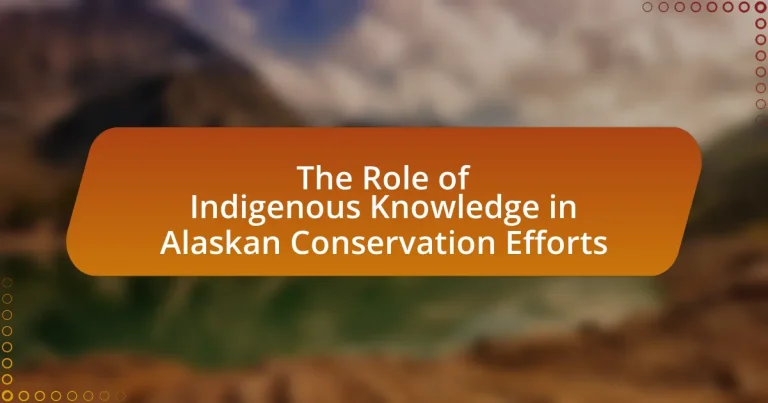The article examines the critical role of Indigenous Knowledge in Alaskan conservation efforts, highlighting its integration with modern ecological practices. It discusses how traditional ecological wisdom, developed over generations, informs sustainable resource management and enhances biodiversity conservation. Key principles of Indigenous Knowledge, such as understanding local ecosystems and community engagement, are explored, along with the challenges Indigenous communities face in applying their knowledge within existing legal and political frameworks. The article also outlines best practices for incorporating Indigenous perspectives into conservation planning and emphasizes the importance of collaboration between Indigenous peoples and conservation organizations for effective environmental stewardship.

What is the Role of Indigenous Knowledge in Alaskan Conservation Efforts?
Indigenous knowledge plays a crucial role in Alaskan conservation efforts by integrating traditional ecological practices with modern conservation strategies. This knowledge, accumulated over generations, provides insights into local ecosystems, species behavior, and sustainable resource management. For instance, Indigenous communities in Alaska have long understood the migratory patterns of fish and wildlife, which informs contemporary conservation policies aimed at preserving these species. Research indicates that incorporating Indigenous perspectives can enhance biodiversity conservation, as seen in the collaborative management of marine resources in the Bering Sea, where local knowledge significantly contributes to sustainable fishing practices.
How does Indigenous Knowledge contribute to conservation practices in Alaska?
Indigenous Knowledge significantly contributes to conservation practices in Alaska by integrating traditional ecological wisdom with contemporary environmental management. This knowledge encompasses a deep understanding of local ecosystems, species behavior, and sustainable resource use, which has been developed over thousands of years. For instance, Indigenous communities utilize seasonal patterns and animal migration data to inform hunting and fishing practices, ensuring that these activities do not deplete resources. Research indicates that areas managed with Indigenous stewardship often show higher biodiversity and resilience to climate change, as seen in the work of the Indigenous Peoples Council for Marine Mammals, which emphasizes the importance of traditional practices in marine conservation.
What are the key principles of Indigenous Knowledge relevant to conservation?
The key principles of Indigenous Knowledge relevant to conservation include a deep understanding of local ecosystems, sustainable resource management, and the integration of cultural practices with environmental stewardship. Indigenous communities possess extensive knowledge about biodiversity, seasonal changes, and the interdependence of species, which informs their conservation strategies. For instance, traditional ecological knowledge has been shown to enhance biodiversity conservation efforts, as evidenced by studies indicating that Indigenous-managed lands often exhibit higher levels of biodiversity compared to non-Indigenous areas. This knowledge is passed down through generations, emphasizing the importance of community involvement and respect for nature, which are crucial for effective conservation practices.
How is Indigenous Knowledge integrated into modern conservation strategies?
Indigenous Knowledge is integrated into modern conservation strategies by incorporating traditional ecological practices and local insights into resource management. This integration is evident in collaborative efforts between Indigenous communities and conservation organizations, where Indigenous peoples contribute their understanding of local ecosystems, species behavior, and sustainable practices. For instance, the Alaska Native Claims Settlement Act has facilitated partnerships that leverage Indigenous Knowledge in managing wildlife populations and habitat restoration, leading to more effective conservation outcomes. Studies have shown that areas managed with Indigenous input often exhibit higher biodiversity and resilience, demonstrating the value of these traditional practices in contemporary conservation efforts.
Why is Indigenous Knowledge important for biodiversity conservation in Alaska?
Indigenous Knowledge is crucial for biodiversity conservation in Alaska because it encompasses traditional ecological wisdom that has been developed over thousands of years. This knowledge includes understanding local ecosystems, species behaviors, and sustainable resource management practices that are tailored to the unique environmental conditions of Alaska. For instance, Indigenous communities have historically managed fish and wildlife populations through practices that ensure their sustainability, which is evidenced by the successful management of salmon runs that have been maintained for generations. Furthermore, Indigenous Knowledge contributes to contemporary conservation efforts by integrating cultural values and community involvement, leading to more effective and culturally relevant conservation strategies.
What unique insights does Indigenous Knowledge provide about local ecosystems?
Indigenous Knowledge offers unique insights into local ecosystems by emphasizing the interconnectedness of species, seasonal changes, and sustainable resource management. This knowledge, accumulated over generations, includes detailed observations of animal behaviors, plant growth cycles, and environmental changes, which are critical for understanding ecosystem dynamics. For instance, Indigenous communities in Alaska have documented the migration patterns of caribou and the effects of climate change on these patterns, providing valuable data for conservation efforts. Such insights are essential for developing effective management strategies that align with ecological balance and cultural practices.
How does Indigenous Knowledge enhance community engagement in conservation?
Indigenous Knowledge enhances community engagement in conservation by fostering a deep connection between local communities and their environment, leading to more effective conservation practices. This knowledge, rooted in centuries of experience, provides insights into sustainable resource management and ecological balance, which are often overlooked in conventional conservation strategies. For instance, Indigenous practices such as seasonal hunting and fishing align with ecological cycles, promoting biodiversity and ecosystem health. Studies have shown that integrating Indigenous Knowledge into conservation efforts can increase community participation by ensuring that local voices are heard and respected, thereby enhancing the legitimacy and success of conservation initiatives.
What challenges do Indigenous communities face in applying their knowledge to conservation?
Indigenous communities face significant challenges in applying their knowledge to conservation, primarily due to systemic barriers such as legal restrictions, lack of recognition, and resource limitations. Legal frameworks often do not acknowledge Indigenous rights to land and resources, which hinders their ability to implement traditional conservation practices. Additionally, there is frequently a lack of institutional support and funding for Indigenous-led conservation initiatives, limiting their capacity to engage effectively. Furthermore, the marginalization of Indigenous knowledge in favor of Western scientific approaches can lead to conflicts and misunderstandings, undermining the integration of traditional ecological knowledge into broader conservation strategies. These challenges are compounded by historical injustices and ongoing socio-economic disparities that Indigenous communities face, which further restrict their participation in conservation efforts.
How do legal and political frameworks impact Indigenous conservation efforts?
Legal and political frameworks significantly influence Indigenous conservation efforts by determining the rights and responsibilities of Indigenous communities regarding land and resource management. These frameworks can either empower Indigenous groups through recognition of land rights and self-determination or hinder their efforts by imposing external regulations that do not align with traditional practices. For instance, the Alaska Native Claims Settlement Act of 1971 provided Alaska Natives with land rights, enabling them to engage in conservation practices that reflect their cultural values and ecological knowledge. Conversely, restrictive policies can limit access to traditional lands, undermining Indigenous stewardship and conservation initiatives.
What are the barriers to collaboration between Indigenous communities and conservation organizations?
Barriers to collaboration between Indigenous communities and conservation organizations include differing priorities, lack of trust, and inadequate representation. Indigenous communities often prioritize cultural preservation and traditional practices, while conservation organizations may focus on biodiversity and ecological metrics, leading to conflicting goals. Additionally, historical injustices and marginalization contribute to a lack of trust between these groups, making collaboration challenging. Furthermore, Indigenous voices are frequently underrepresented in decision-making processes, which can hinder effective partnerships. These factors collectively impede the potential for successful collaboration in conservation efforts.
How can Indigenous Knowledge be effectively documented and preserved?
Indigenous Knowledge can be effectively documented and preserved through collaborative approaches that involve Indigenous communities in the process. Engaging local elders and knowledge holders ensures that the documentation reflects authentic cultural practices and perspectives. Utilizing multimedia tools, such as audio recordings, videos, and digital archives, enhances accessibility and preservation of this knowledge. Research indicates that projects like the “Indigenous Knowledge and Climate Change” initiative have successfully integrated traditional ecological knowledge with scientific data, demonstrating the value of such collaborative documentation efforts. Furthermore, establishing legal frameworks that recognize and protect Indigenous intellectual property rights is crucial for safeguarding this knowledge against exploitation.
What are the best practices for incorporating Indigenous Knowledge into conservation planning?
The best practices for incorporating Indigenous Knowledge into conservation planning include establishing collaborative partnerships with Indigenous communities, integrating traditional ecological knowledge (TEK) into scientific frameworks, and ensuring the active participation of Indigenous peoples in decision-making processes. Collaborative partnerships foster mutual respect and understanding, allowing for the sharing of knowledge and resources. Integrating TEK into scientific frameworks enhances the effectiveness of conservation strategies by combining empirical data with local insights. Active participation ensures that Indigenous perspectives and values are reflected in conservation goals, leading to more culturally relevant and sustainable outcomes. These practices are supported by case studies demonstrating successful conservation initiatives in Alaska, where Indigenous Knowledge has been pivotal in managing natural resources and preserving biodiversity.
How can stakeholders ensure respect for Indigenous Knowledge in conservation initiatives?
Stakeholders can ensure respect for Indigenous Knowledge in conservation initiatives by actively involving Indigenous communities in decision-making processes. This involvement includes recognizing and integrating traditional ecological knowledge, which has been developed over generations and is crucial for effective conservation strategies. For instance, studies have shown that Indigenous management practices can enhance biodiversity and ecosystem resilience, as evidenced by the successful co-management of marine resources in Alaska, where local Indigenous knowledge significantly informed sustainable fishing practices. By fostering partnerships and ensuring that Indigenous voices are heard and valued, stakeholders can create more effective and culturally respectful conservation initiatives.
What role does education play in promoting Indigenous Knowledge for conservation?
Education plays a crucial role in promoting Indigenous Knowledge for conservation by facilitating the transfer of traditional ecological practices and cultural values to both Indigenous and non-Indigenous communities. This educational process enhances understanding of sustainable practices that have been developed over generations, such as land stewardship and resource management techniques that are vital for ecosystem health. For instance, programs that integrate Indigenous perspectives into school curricula have been shown to improve environmental awareness and foster respect for Indigenous cultures, as evidenced by initiatives in Alaska where local schools incorporate traditional knowledge into their science programs, leading to increased community engagement in conservation efforts.
What future opportunities exist for Indigenous Knowledge in Alaskan conservation efforts?
Future opportunities for Indigenous Knowledge in Alaskan conservation efforts include enhanced collaboration between Indigenous communities and conservation organizations, leading to more effective management of natural resources. This collaboration can leverage traditional ecological knowledge, which has been practiced for thousands of years, to inform contemporary conservation strategies. For instance, Indigenous practices in fire management and wildlife stewardship have shown to improve ecosystem resilience, as evidenced by studies indicating that areas managed with Indigenous techniques often exhibit greater biodiversity and ecological health. Additionally, integrating Indigenous perspectives into climate adaptation strategies can provide valuable insights into sustainable practices that align with local ecosystems, further supporting conservation goals.
How can technology support the integration of Indigenous Knowledge in conservation?
Technology can support the integration of Indigenous Knowledge in conservation by facilitating data collection, enhancing communication, and enabling collaborative platforms. For instance, Geographic Information Systems (GIS) allow Indigenous communities to map traditional land use and ecological knowledge, providing valuable data for conservation planning. Additionally, mobile applications can be developed to document and share Indigenous practices and observations, ensuring that this knowledge is preserved and accessible. Research by the University of Alaska Fairbanks highlights that integrating Indigenous Knowledge with scientific data through technology leads to more effective conservation strategies, as it combines traditional ecological insights with modern scientific approaches.
What collaborative models can enhance the effectiveness of Indigenous Knowledge in conservation?
Collaborative models that can enhance the effectiveness of Indigenous Knowledge in conservation include co-management frameworks, participatory research initiatives, and community-based conservation programs. Co-management frameworks, such as those established in Alaska, allow Indigenous communities and government agencies to share decision-making responsibilities, ensuring that traditional ecological knowledge is integrated into conservation strategies. Participatory research initiatives engage Indigenous peoples in the research process, validating their knowledge and fostering mutual respect between scientists and local communities. Community-based conservation programs empower Indigenous groups to manage their natural resources, leading to sustainable practices that reflect their cultural values and ecological understanding. These models have been shown to improve conservation outcomes by aligning scientific approaches with Indigenous perspectives, as evidenced by successful case studies in Alaska where such collaborations have led to enhanced biodiversity and ecosystem health.
What practical steps can be taken to support Indigenous Knowledge in conservation efforts?
Practical steps to support Indigenous Knowledge in conservation efforts include integrating Indigenous perspectives into policy-making, fostering partnerships between Indigenous communities and conservation organizations, and providing platforms for Indigenous voices in environmental decision-making. For instance, the U.S. government has recognized the importance of Indigenous Knowledge through initiatives like the Alaska Native Claims Settlement Act, which emphasizes collaboration with Indigenous peoples in managing natural resources. Additionally, research shows that Indigenous land management practices, such as controlled burns, enhance biodiversity and ecosystem resilience, demonstrating the effectiveness of incorporating traditional ecological knowledge into contemporary conservation strategies.


